Finance for Strategic Managers: Financial Management Report
VerifiedAdded on 2019/12/03
|20
|5538
|153
Report
AI Summary
This report, titled "Finance for Strategic Managers," delves into the critical role of financial information in business decision-making, using Debenhams as a case study. It begins by assessing the necessity of financial data, identifying associated business risks, and summarizing essential financial information for strategic decisions. The report then defines the purpose, structure, and content of published accounts, interpreting the information and calculating financial ratios to support strategic choices. It differentiates between short and long-term financial requirements, compares funding sources, and examines cash flow management techniques. Finally, the report considers business ownership structures, roles, and accountability, evaluating methods for appraising strategic capital and investment projects, supported by tables and financial analysis. The analysis includes profitability, liquidity, efficiency, and gearing ratios. The report aims to provide a comprehensive understanding of financial management principles and their practical application.
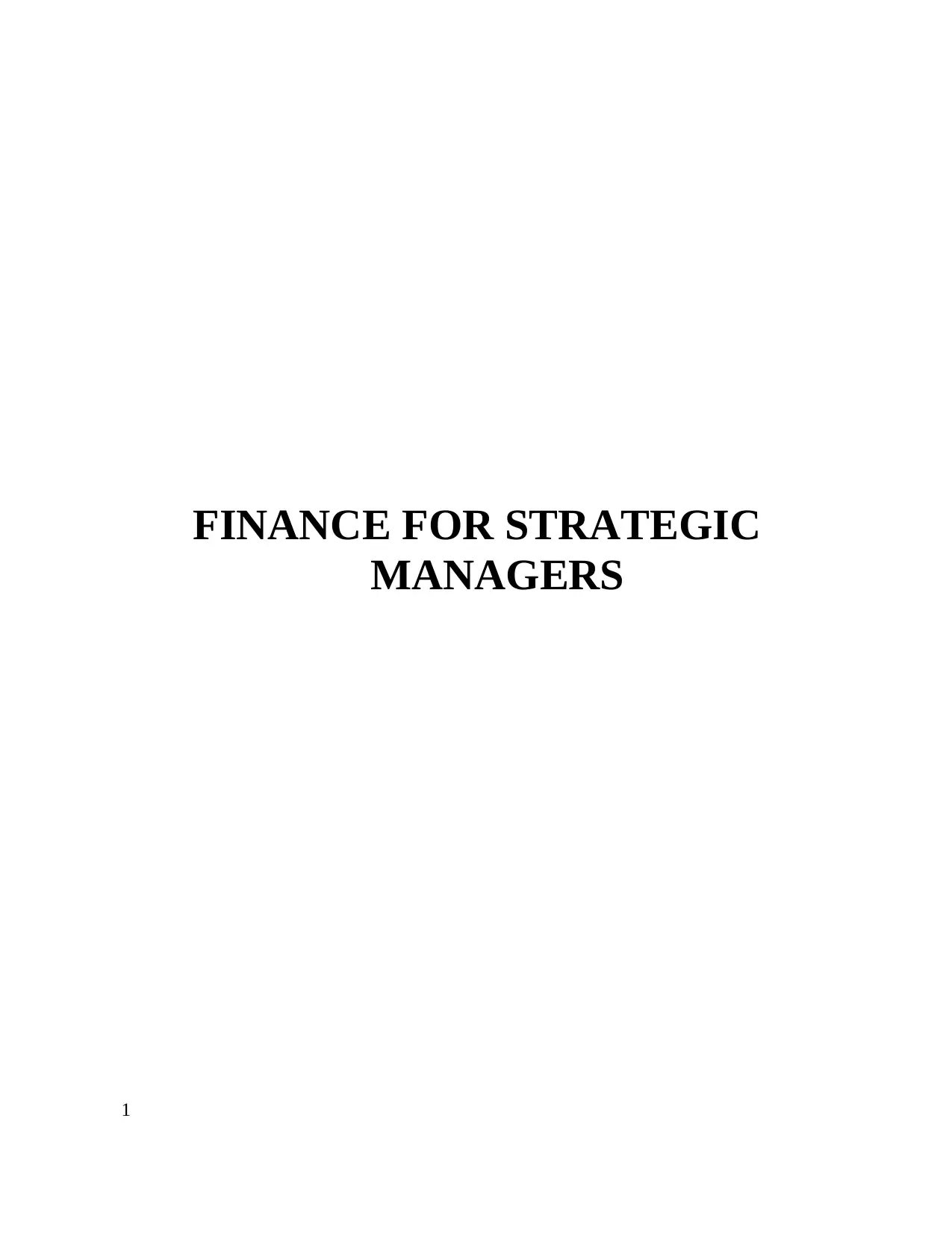
FINANCE FOR STRATEGIC
MANAGERS
1
MANAGERS
1
Paraphrase This Document
Need a fresh take? Get an instant paraphrase of this document with our AI Paraphraser

TABLE OF CONTENTS
INTRODUCTION...........................................................................................................................4
TASK 1............................................................................................................................................4
1.1 An assessment of the reason for which financial information is needed in business............4
1.2 Identification of business risks related to financial decisions................................................5
1.3 Summary of financial information that is needed to make strategic business decision........5
TASK 2............................................................................................................................................6
2.1 Defining purpose, structure and content of published accounts............................................6
2.2 Interpreting information in these accounts............................................................................8
2.3 Calculating financial ratios from the accounts and the way in which they support strategic
decision making...........................................................................................................................8
TASK 3..........................................................................................................................................10
3.1 Difference between long and short term financial requirement of businesses....................10
3.2 Comparison between long and short term source of finance...............................................11
3.3 Cash flow management techniques and assessment of the reason for which the
management of cash flow is so important.................................................................................12
TASK 4..........................................................................................................................................12
4.1 Considering different business ownership structures and roles and accountability of owners
and managers in making decisions............................................................................................12
4.2 Evaluation of methods for appraising strategic capital or investment projects...................13
CONCLUSION..............................................................................................................................15
REFERENCES..............................................................................................................................16
2
INTRODUCTION...........................................................................................................................4
TASK 1............................................................................................................................................4
1.1 An assessment of the reason for which financial information is needed in business............4
1.2 Identification of business risks related to financial decisions................................................5
1.3 Summary of financial information that is needed to make strategic business decision........5
TASK 2............................................................................................................................................6
2.1 Defining purpose, structure and content of published accounts............................................6
2.2 Interpreting information in these accounts............................................................................8
2.3 Calculating financial ratios from the accounts and the way in which they support strategic
decision making...........................................................................................................................8
TASK 3..........................................................................................................................................10
3.1 Difference between long and short term financial requirement of businesses....................10
3.2 Comparison between long and short term source of finance...............................................11
3.3 Cash flow management techniques and assessment of the reason for which the
management of cash flow is so important.................................................................................12
TASK 4..........................................................................................................................................12
4.1 Considering different business ownership structures and roles and accountability of owners
and managers in making decisions............................................................................................12
4.2 Evaluation of methods for appraising strategic capital or investment projects...................13
CONCLUSION..............................................................................................................................15
REFERENCES..............................................................................................................................16
2
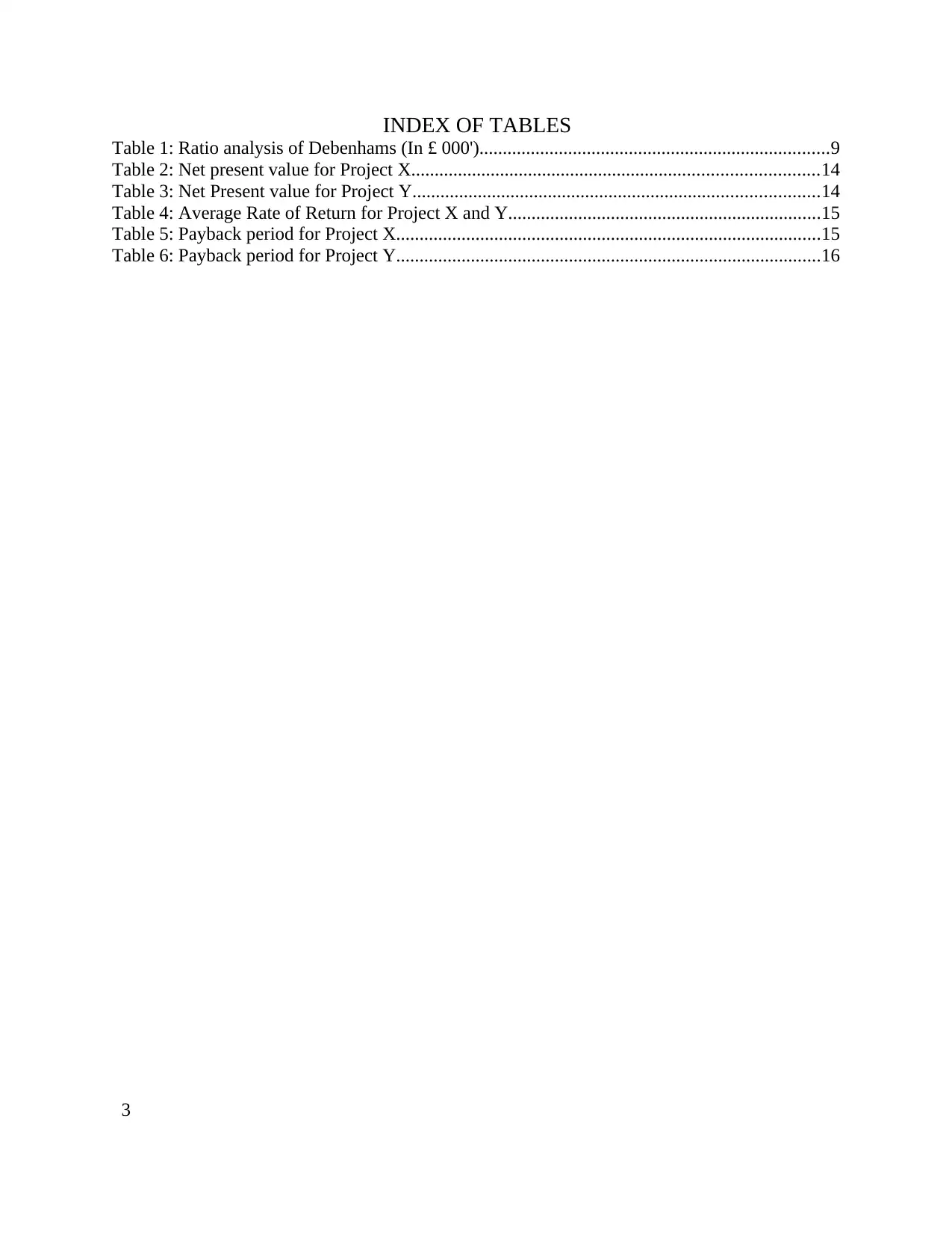
INDEX OF TABLES
Table 1: Ratio analysis of Debenhams (In £ 000')...........................................................................9
Table 2: Net present value for Project X.......................................................................................14
Table 3: Net Present value for Project Y.......................................................................................14
Table 4: Average Rate of Return for Project X and Y...................................................................15
Table 5: Payback period for Project X...........................................................................................15
Table 6: Payback period for Project Y...........................................................................................16
3
Table 1: Ratio analysis of Debenhams (In £ 000')...........................................................................9
Table 2: Net present value for Project X.......................................................................................14
Table 3: Net Present value for Project Y.......................................................................................14
Table 4: Average Rate of Return for Project X and Y...................................................................15
Table 5: Payback period for Project X...........................................................................................15
Table 6: Payback period for Project Y...........................................................................................16
3
⊘ This is a preview!⊘
Do you want full access?
Subscribe today to unlock all pages.

Trusted by 1+ million students worldwide

INTRODUCTION
Management of financial resources plays a crucial role in accomplishing the business
objectives of organization. Strategic financial management involves a defined series of steps that
includes setting of business goals, identifying resources, analysis of data and finally, making the
decisions (Banerjee, 2015).
In this project report, there is a discussion regarding the financial aspect of Debenhams
which is one of the leading retailing companies of UK. The report gives focus on the comparison
between short and long term finance for business as well as on the importance of management of
cash flows and other financial statements.
TASK 1
1.1 An assessment of the reason for which financial information is needed in business
Financial information works as the heart of business. Financial information plays a very
important role in making financial planning and decision. Financial information is mainly
collected from various financial accounting statements. Financial statement like balance sheet
helps in giving the exact picture of assets and liabilities which is important for the organization
(Smit and Trigeorgis, 2012). It helps in identifying the exact financial position of business which
results in making the final judgement regarding business expansion. Profit and loss account gives
information regarding the wages that are paid out of the business and expenses that occur in the
firm. On the basis of financial information which is collected from the profit and loss account,
Debenhams can identify the efficiency and performance of business. Through the information
taken from profit and loss account or income statement, investors can evaluate the company's
past performance and can assess the uncertainty of future cash flow (Ball, Jayaraman and
Shivakumar, 2012). Financial information is needed to find out or to maintain the record of
success of business. The financial information is collected from the financial ratio which helps in
analysing the actual performance of company as compared with its financial objectives (Wheelen
and Hunger, 2011). With the help of financial information, Debenhams can measure or examine
the quality and position of business which helps in making assumptions for more successful
business in the future. By collecting the financial information, true and fair presentation of
business efficiency can be examined.
4
Management of financial resources plays a crucial role in accomplishing the business
objectives of organization. Strategic financial management involves a defined series of steps that
includes setting of business goals, identifying resources, analysis of data and finally, making the
decisions (Banerjee, 2015).
In this project report, there is a discussion regarding the financial aspect of Debenhams
which is one of the leading retailing companies of UK. The report gives focus on the comparison
between short and long term finance for business as well as on the importance of management of
cash flows and other financial statements.
TASK 1
1.1 An assessment of the reason for which financial information is needed in business
Financial information works as the heart of business. Financial information plays a very
important role in making financial planning and decision. Financial information is mainly
collected from various financial accounting statements. Financial statement like balance sheet
helps in giving the exact picture of assets and liabilities which is important for the organization
(Smit and Trigeorgis, 2012). It helps in identifying the exact financial position of business which
results in making the final judgement regarding business expansion. Profit and loss account gives
information regarding the wages that are paid out of the business and expenses that occur in the
firm. On the basis of financial information which is collected from the profit and loss account,
Debenhams can identify the efficiency and performance of business. Through the information
taken from profit and loss account or income statement, investors can evaluate the company's
past performance and can assess the uncertainty of future cash flow (Ball, Jayaraman and
Shivakumar, 2012). Financial information is needed to find out or to maintain the record of
success of business. The financial information is collected from the financial ratio which helps in
analysing the actual performance of company as compared with its financial objectives (Wheelen
and Hunger, 2011). With the help of financial information, Debenhams can measure or examine
the quality and position of business which helps in making assumptions for more successful
business in the future. By collecting the financial information, true and fair presentation of
business efficiency can be examined.
4
Paraphrase This Document
Need a fresh take? Get an instant paraphrase of this document with our AI Paraphraser

1.2 Identification of business risks related to financial decisions
Risk related to a financial decisions refer to the possibility of a loss or default ion the
organization. Risk is one of the major factors which creates problem in front of company while
making the financial decision. There are various risk factors which affect the financial and
business decision of Dagenham. They are as followed-
Macroeconomic condition of market – Market condition affects the revenue of company
in case of fluctuation or a slowdown in the market.
Uncertainty of investment- There are high risk related to the uncertainty of firm's return
over its assets (Beck, Levine and Loayza, 2000). For example, the firm may or may not
receive the expected return for the capital.
Credit Risk:- This risk is associated with the borrowing of the business going into default.
Investors may loss their principal and interest if any creditors refuses to pay the borrowed
money due to any reason (Jõeveer, 2013).
Liquidity Risk- This risk arises when the asset or the commodity can not be easily traded
in the market. There can be loss in the assets liquidity or funding of the liquidity
(Brealey, 2012). These risk arise when asset cannot be sold in the market due to any
market risk and and when the asset does not meet the demand in the market, respectively.
Market Risk- There are greater risk related to the market like, falling prices of the stock
of the company, high interest rates prevailing in the market, fluctuations in the foreign
exchange rate and rise in the price of the commodity like oil, gas and etc (Banerjee,
2015).
Sales risk- It is affected when demand of company’s product as well as through the price
per unit of product (Guzman, 2015) falls. For example, company like Debenhams which
is a retail firm is having high amount of business risk due to uncertainty of demand of its
product in the market.
5
Risk related to a financial decisions refer to the possibility of a loss or default ion the
organization. Risk is one of the major factors which creates problem in front of company while
making the financial decision. There are various risk factors which affect the financial and
business decision of Dagenham. They are as followed-
Macroeconomic condition of market – Market condition affects the revenue of company
in case of fluctuation or a slowdown in the market.
Uncertainty of investment- There are high risk related to the uncertainty of firm's return
over its assets (Beck, Levine and Loayza, 2000). For example, the firm may or may not
receive the expected return for the capital.
Credit Risk:- This risk is associated with the borrowing of the business going into default.
Investors may loss their principal and interest if any creditors refuses to pay the borrowed
money due to any reason (Jõeveer, 2013).
Liquidity Risk- This risk arises when the asset or the commodity can not be easily traded
in the market. There can be loss in the assets liquidity or funding of the liquidity
(Brealey, 2012). These risk arise when asset cannot be sold in the market due to any
market risk and and when the asset does not meet the demand in the market, respectively.
Market Risk- There are greater risk related to the market like, falling prices of the stock
of the company, high interest rates prevailing in the market, fluctuations in the foreign
exchange rate and rise in the price of the commodity like oil, gas and etc (Banerjee,
2015).
Sales risk- It is affected when demand of company’s product as well as through the price
per unit of product (Guzman, 2015) falls. For example, company like Debenhams which
is a retail firm is having high amount of business risk due to uncertainty of demand of its
product in the market.
5

Other business risk includes demand variability, product quality, research and
development activities, input cost variability etc.
1.3 Summary of financial information that is needed to make strategic business decision
The finance department of company generates variety of financial information that is
helpful in the decision making. By proper collection of financial information, Debenhams can be
benefited in the following way. Decision Making- Financial information helps in deciding the business strategies for
example, ways to reduce cost can be figured by accessing the financial statements which
consists of the operating cost indulged in a certain product (Jõeveer, 2013). Facilitates Credit – Financial information helps a company or a business to make
decision about the credit requirements. There are many instances in which company
requires credit from the market or a lender. In these cases financial information provides
insights about whether a decision can be made to take credit from the marker or not.
(Kono and Barnes, 2015).
Helps in calculation- With the help of financial information, managers can make
calculations about the feasibility of a certain decision. It is important for the company to
accumulate the feasibility and success of a certain decision made by the management and
the top level of the organization (Cheng and Humphreys, 2012). of the firm can make a
plan about all the measures that can be adopted to raise the profitability of company.
Improves purchasing skills - Financial information helps in deciding the time and cost to
purchase a new capital assets (Davison and Warren, 2009). For example, if Debenhams is
planning to expand its business then in that case, company wants to purchase new capital
asset. Financial information collected from the balance sheet and cash flow statement will
help in making the right purchase decision.
TASK 2
2.1 Defining purpose, structure and content of published accounts
The purpose of financial statement is as under:
Financial statement is prepared by company in order to present the information in front of
internal and external stakeholders (Drake and Fabozzi, 2012). The other main purpose of
6
development activities, input cost variability etc.
1.3 Summary of financial information that is needed to make strategic business decision
The finance department of company generates variety of financial information that is
helpful in the decision making. By proper collection of financial information, Debenhams can be
benefited in the following way. Decision Making- Financial information helps in deciding the business strategies for
example, ways to reduce cost can be figured by accessing the financial statements which
consists of the operating cost indulged in a certain product (Jõeveer, 2013). Facilitates Credit – Financial information helps a company or a business to make
decision about the credit requirements. There are many instances in which company
requires credit from the market or a lender. In these cases financial information provides
insights about whether a decision can be made to take credit from the marker or not.
(Kono and Barnes, 2015).
Helps in calculation- With the help of financial information, managers can make
calculations about the feasibility of a certain decision. It is important for the company to
accumulate the feasibility and success of a certain decision made by the management and
the top level of the organization (Cheng and Humphreys, 2012). of the firm can make a
plan about all the measures that can be adopted to raise the profitability of company.
Improves purchasing skills - Financial information helps in deciding the time and cost to
purchase a new capital assets (Davison and Warren, 2009). For example, if Debenhams is
planning to expand its business then in that case, company wants to purchase new capital
asset. Financial information collected from the balance sheet and cash flow statement will
help in making the right purchase decision.
TASK 2
2.1 Defining purpose, structure and content of published accounts
The purpose of financial statement is as under:
Financial statement is prepared by company in order to present the information in front of
internal and external stakeholders (Drake and Fabozzi, 2012). The other main purpose of
6
⊘ This is a preview!⊘
Do you want full access?
Subscribe today to unlock all pages.

Trusted by 1+ million students worldwide
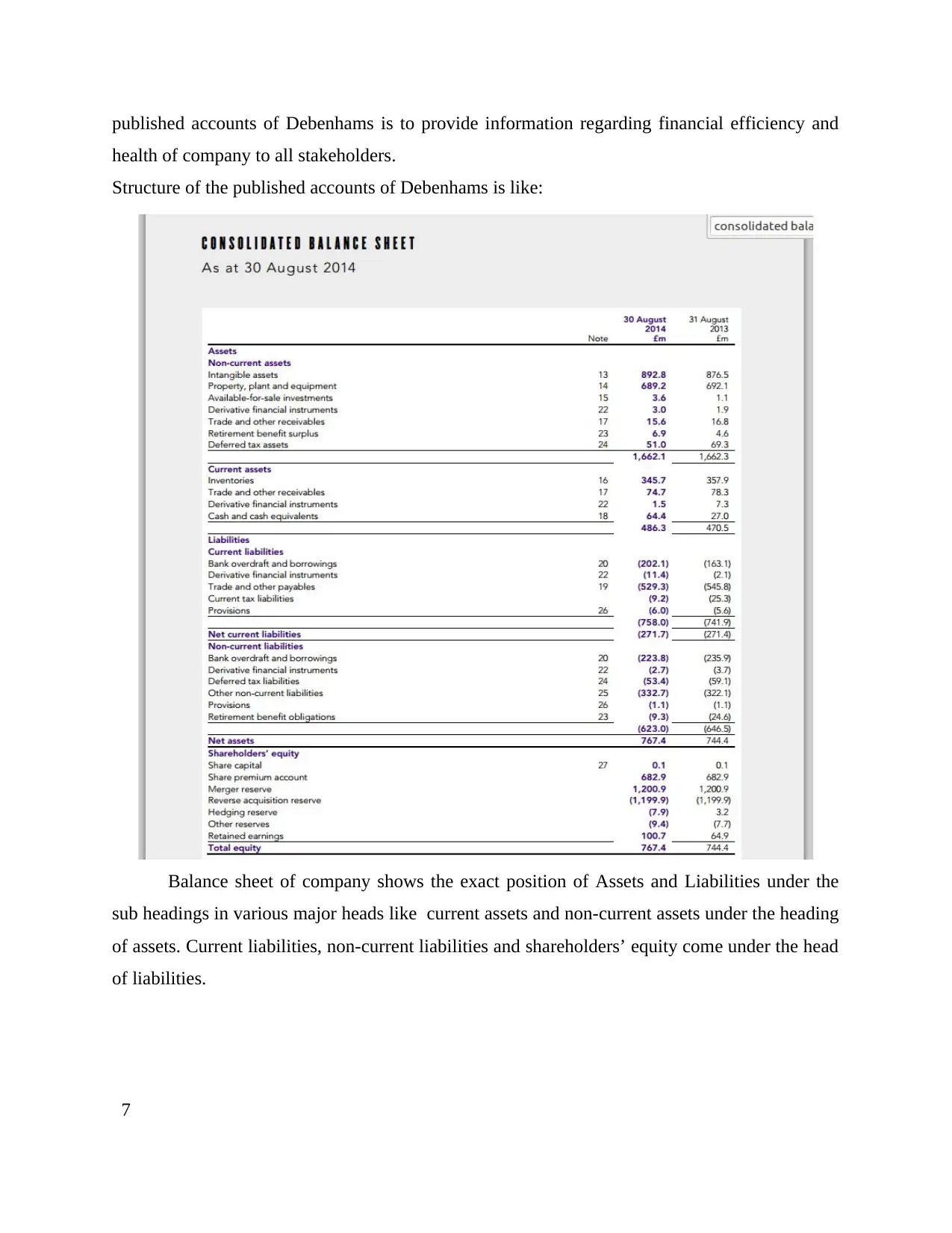
published accounts of Debenhams is to provide information regarding financial efficiency and
health of company to all stakeholders.
Structure of the published accounts of Debenhams is like:
Balance sheet of company shows the exact position of Assets and Liabilities under the
sub headings in various major heads like current assets and non-current assets under the heading
of assets. Current liabilities, non-current liabilities and shareholders’ equity come under the head
of liabilities.
7
health of company to all stakeholders.
Structure of the published accounts of Debenhams is like:
Balance sheet of company shows the exact position of Assets and Liabilities under the
sub headings in various major heads like current assets and non-current assets under the heading
of assets. Current liabilities, non-current liabilities and shareholders’ equity come under the head
of liabilities.
7
Paraphrase This Document
Need a fresh take? Get an instant paraphrase of this document with our AI Paraphraser
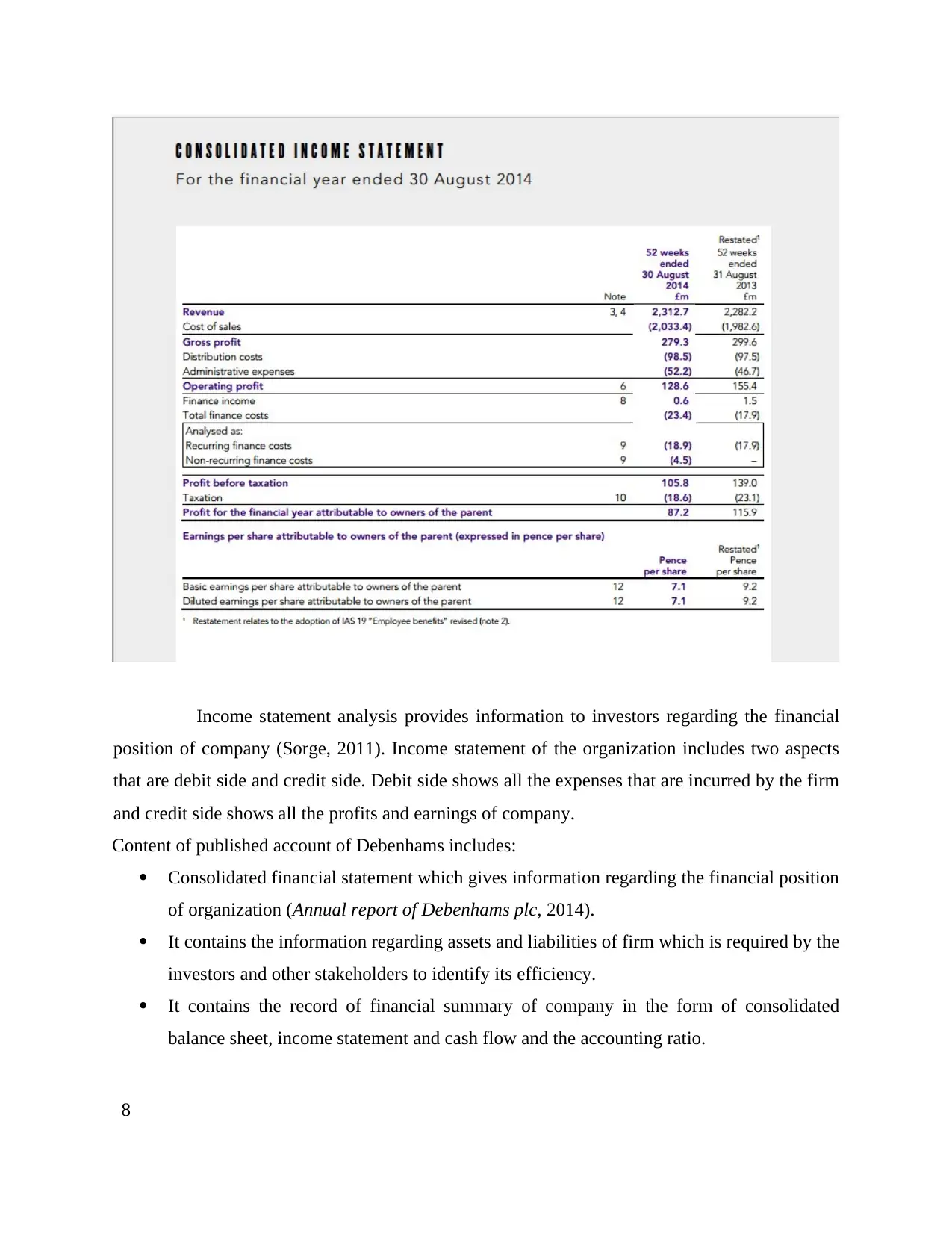
Income statement analysis provides information to investors regarding the financial
position of company (Sorge, 2011). Income statement of the organization includes two aspects
that are debit side and credit side. Debit side shows all the expenses that are incurred by the firm
and credit side shows all the profits and earnings of company.
Content of published account of Debenhams includes:
Consolidated financial statement which gives information regarding the financial position
of organization (Annual report of Debenhams plc, 2014).
It contains the information regarding assets and liabilities of firm which is required by the
investors and other stakeholders to identify its efficiency.
It contains the record of financial summary of company in the form of consolidated
balance sheet, income statement and cash flow and the accounting ratio.
8
position of company (Sorge, 2011). Income statement of the organization includes two aspects
that are debit side and credit side. Debit side shows all the expenses that are incurred by the firm
and credit side shows all the profits and earnings of company.
Content of published account of Debenhams includes:
Consolidated financial statement which gives information regarding the financial position
of organization (Annual report of Debenhams plc, 2014).
It contains the information regarding assets and liabilities of firm which is required by the
investors and other stakeholders to identify its efficiency.
It contains the record of financial summary of company in the form of consolidated
balance sheet, income statement and cash flow and the accounting ratio.
8
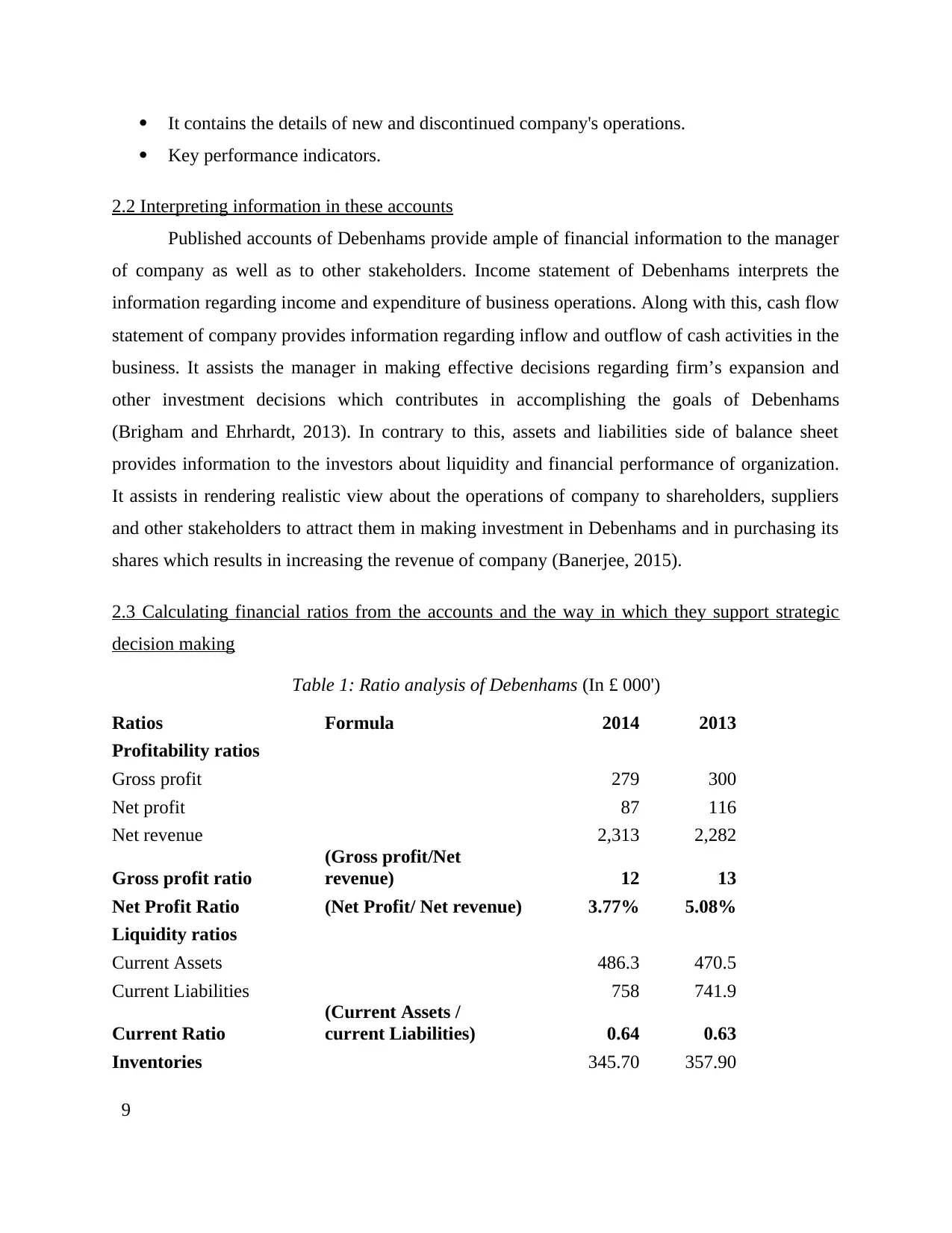
It contains the details of new and discontinued company's operations.
Key performance indicators.
2.2 Interpreting information in these accounts
Published accounts of Debenhams provide ample of financial information to the manager
of company as well as to other stakeholders. Income statement of Debenhams interprets the
information regarding income and expenditure of business operations. Along with this, cash flow
statement of company provides information regarding inflow and outflow of cash activities in the
business. It assists the manager in making effective decisions regarding firm’s expansion and
other investment decisions which contributes in accomplishing the goals of Debenhams
(Brigham and Ehrhardt, 2013). In contrary to this, assets and liabilities side of balance sheet
provides information to the investors about liquidity and financial performance of organization.
It assists in rendering realistic view about the operations of company to shareholders, suppliers
and other stakeholders to attract them in making investment in Debenhams and in purchasing its
shares which results in increasing the revenue of company (Banerjee, 2015).
2.3 Calculating financial ratios from the accounts and the way in which they support strategic
decision making
Table 1: Ratio analysis of Debenhams (In £ 000')
Ratios Formula 2014 2013
Profitability ratios
Gross profit 279 300
Net profit 87 116
Net revenue 2,313 2,282
Gross profit ratio
(Gross profit/Net
revenue) 12 13
Net Profit Ratio (Net Profit/ Net revenue) 3.77% 5.08%
Liquidity ratios
Current Assets 486.3 470.5
Current Liabilities 758 741.9
Current Ratio
(Current Assets /
current Liabilities) 0.64 0.63
Inventories 345.70 357.90
9
Key performance indicators.
2.2 Interpreting information in these accounts
Published accounts of Debenhams provide ample of financial information to the manager
of company as well as to other stakeholders. Income statement of Debenhams interprets the
information regarding income and expenditure of business operations. Along with this, cash flow
statement of company provides information regarding inflow and outflow of cash activities in the
business. It assists the manager in making effective decisions regarding firm’s expansion and
other investment decisions which contributes in accomplishing the goals of Debenhams
(Brigham and Ehrhardt, 2013). In contrary to this, assets and liabilities side of balance sheet
provides information to the investors about liquidity and financial performance of organization.
It assists in rendering realistic view about the operations of company to shareholders, suppliers
and other stakeholders to attract them in making investment in Debenhams and in purchasing its
shares which results in increasing the revenue of company (Banerjee, 2015).
2.3 Calculating financial ratios from the accounts and the way in which they support strategic
decision making
Table 1: Ratio analysis of Debenhams (In £ 000')
Ratios Formula 2014 2013
Profitability ratios
Gross profit 279 300
Net profit 87 116
Net revenue 2,313 2,282
Gross profit ratio
(Gross profit/Net
revenue) 12 13
Net Profit Ratio (Net Profit/ Net revenue) 3.77% 5.08%
Liquidity ratios
Current Assets 486.3 470.5
Current Liabilities 758 741.9
Current Ratio
(Current Assets /
current Liabilities) 0.64 0.63
Inventories 345.70 357.90
9
⊘ This is a preview!⊘
Do you want full access?
Subscribe today to unlock all pages.

Trusted by 1+ million students worldwide
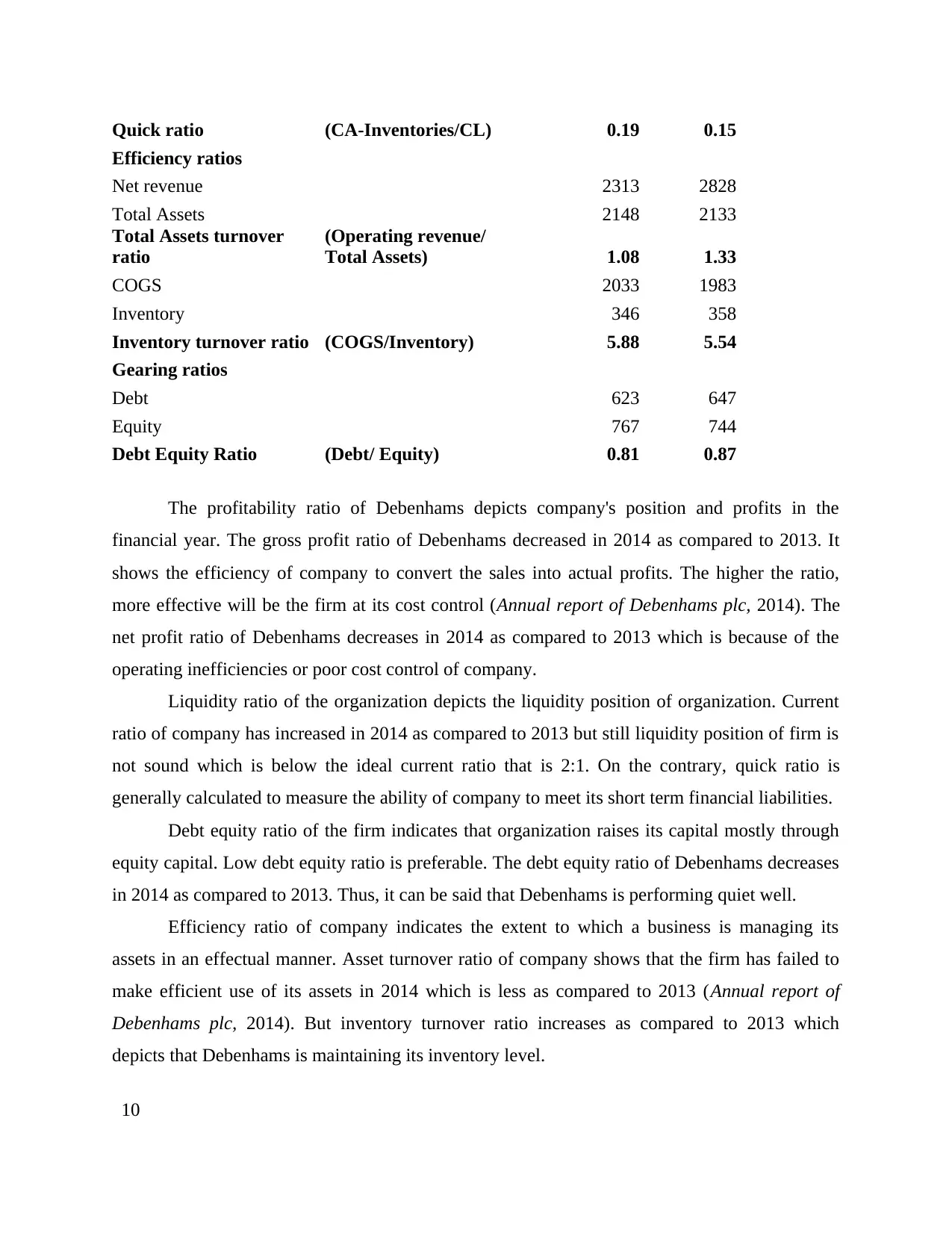
Quick ratio (CA-Inventories/CL) 0.19 0.15
Efficiency ratios
Net revenue 2313 2828
Total Assets 2148 2133
Total Assets turnover
ratio
(Operating revenue/
Total Assets) 1.08 1.33
COGS 2033 1983
Inventory 346 358
Inventory turnover ratio (COGS/Inventory) 5.88 5.54
Gearing ratios
Debt 623 647
Equity 767 744
Debt Equity Ratio (Debt/ Equity) 0.81 0.87
The profitability ratio of Debenhams depicts company's position and profits in the
financial year. The gross profit ratio of Debenhams decreased in 2014 as compared to 2013. It
shows the efficiency of company to convert the sales into actual profits. The higher the ratio,
more effective will be the firm at its cost control (Annual report of Debenhams plc, 2014). The
net profit ratio of Debenhams decreases in 2014 as compared to 2013 which is because of the
operating inefficiencies or poor cost control of company.
Liquidity ratio of the organization depicts the liquidity position of organization. Current
ratio of company has increased in 2014 as compared to 2013 but still liquidity position of firm is
not sound which is below the ideal current ratio that is 2:1. On the contrary, quick ratio is
generally calculated to measure the ability of company to meet its short term financial liabilities.
Debt equity ratio of the firm indicates that organization raises its capital mostly through
equity capital. Low debt equity ratio is preferable. The debt equity ratio of Debenhams decreases
in 2014 as compared to 2013. Thus, it can be said that Debenhams is performing quiet well.
Efficiency ratio of company indicates the extent to which a business is managing its
assets in an effectual manner. Asset turnover ratio of company shows that the firm has failed to
make efficient use of its assets in 2014 which is less as compared to 2013 (Annual report of
Debenhams plc, 2014). But inventory turnover ratio increases as compared to 2013 which
depicts that Debenhams is maintaining its inventory level.
10
Efficiency ratios
Net revenue 2313 2828
Total Assets 2148 2133
Total Assets turnover
ratio
(Operating revenue/
Total Assets) 1.08 1.33
COGS 2033 1983
Inventory 346 358
Inventory turnover ratio (COGS/Inventory) 5.88 5.54
Gearing ratios
Debt 623 647
Equity 767 744
Debt Equity Ratio (Debt/ Equity) 0.81 0.87
The profitability ratio of Debenhams depicts company's position and profits in the
financial year. The gross profit ratio of Debenhams decreased in 2014 as compared to 2013. It
shows the efficiency of company to convert the sales into actual profits. The higher the ratio,
more effective will be the firm at its cost control (Annual report of Debenhams plc, 2014). The
net profit ratio of Debenhams decreases in 2014 as compared to 2013 which is because of the
operating inefficiencies or poor cost control of company.
Liquidity ratio of the organization depicts the liquidity position of organization. Current
ratio of company has increased in 2014 as compared to 2013 but still liquidity position of firm is
not sound which is below the ideal current ratio that is 2:1. On the contrary, quick ratio is
generally calculated to measure the ability of company to meet its short term financial liabilities.
Debt equity ratio of the firm indicates that organization raises its capital mostly through
equity capital. Low debt equity ratio is preferable. The debt equity ratio of Debenhams decreases
in 2014 as compared to 2013. Thus, it can be said that Debenhams is performing quiet well.
Efficiency ratio of company indicates the extent to which a business is managing its
assets in an effectual manner. Asset turnover ratio of company shows that the firm has failed to
make efficient use of its assets in 2014 which is less as compared to 2013 (Annual report of
Debenhams plc, 2014). But inventory turnover ratio increases as compared to 2013 which
depicts that Debenhams is maintaining its inventory level.
10
Paraphrase This Document
Need a fresh take? Get an instant paraphrase of this document with our AI Paraphraser

By this ratio, Debenhams can make the decisions to control the cost. If company
increases its net profit, then it can save some amount as the reserve. This reserve amount can be
utilized for its expansion purpose. The debt equity ratio shows that company is managing its
source of fund from internal or equity financing rather than borrowing from the other debt
sources. By the ratio calculation, actual performance of company is identified by which firm can
take various strategic decisions like expansion, modification in current strategies investment,
purchase of new machinery etc.
TASK 3
3.1 Difference between long and short term financial requirement of businesses
Short-term requirement of funds is to meet the current needs of organization. On the
other hand, long term requirement of funds are for meeting the long term needs of enterprise.
Short-term requirement of funds is to fulfil the current expenses of company like payment of
wages, salary etc. In contrast to this, long term requirement of fund is for expansion, investment,
new launching of product, purchase of fixed assets like building, machinery, furniture etc.
Debenhams is planning to expand its business; in that case, it requires long term sources of
finance (Moyer, McGuigan and Rao, 2014). Short term requirement of fund is for performing the
tactical decisions while long term requirement of funds is for the strategic decisions. Company
can delay to pay to suppliers but sometimes, they demand for the quick payment of raw materials
or finished goods that they have supplied. In that case, to fulfil the short term requirement of
funds, company has to arrange funds from short term sources of finance. Short term financing is
a fast and flexible way for companies to obtain working capital for the daily operations of
business in case when there is insufficient amount of cash flow. In contrast to this, it is quiet a
big procedure to arrange the funds from long term sources of finance. The funds sourced for
short term requirement for Debenhams will not allow it to get the tax benefits. But, in case of
long term sources, that is, debt, Debenhams can enjoy tax saving on the interest on debt.
3.2 Comparison between long and short term source of finance
Basis Long term source Short term source
Time period It is of more than 5 years. It is for less than 1 or less than
11
increases its net profit, then it can save some amount as the reserve. This reserve amount can be
utilized for its expansion purpose. The debt equity ratio shows that company is managing its
source of fund from internal or equity financing rather than borrowing from the other debt
sources. By the ratio calculation, actual performance of company is identified by which firm can
take various strategic decisions like expansion, modification in current strategies investment,
purchase of new machinery etc.
TASK 3
3.1 Difference between long and short term financial requirement of businesses
Short-term requirement of funds is to meet the current needs of organization. On the
other hand, long term requirement of funds are for meeting the long term needs of enterprise.
Short-term requirement of funds is to fulfil the current expenses of company like payment of
wages, salary etc. In contrast to this, long term requirement of fund is for expansion, investment,
new launching of product, purchase of fixed assets like building, machinery, furniture etc.
Debenhams is planning to expand its business; in that case, it requires long term sources of
finance (Moyer, McGuigan and Rao, 2014). Short term requirement of fund is for performing the
tactical decisions while long term requirement of funds is for the strategic decisions. Company
can delay to pay to suppliers but sometimes, they demand for the quick payment of raw materials
or finished goods that they have supplied. In that case, to fulfil the short term requirement of
funds, company has to arrange funds from short term sources of finance. Short term financing is
a fast and flexible way for companies to obtain working capital for the daily operations of
business in case when there is insufficient amount of cash flow. In contrast to this, it is quiet a
big procedure to arrange the funds from long term sources of finance. The funds sourced for
short term requirement for Debenhams will not allow it to get the tax benefits. But, in case of
long term sources, that is, debt, Debenhams can enjoy tax saving on the interest on debt.
3.2 Comparison between long and short term source of finance
Basis Long term source Short term source
Time period It is of more than 5 years. It is for less than 1 or less than
11

a year.
Requirement It enables company to achieve
its long term requirement of
funds.
It enables to achieve short term
requirement of the firm.
ObjectiveLong term sources of
finance prove to be beneficial
for high investment projects
(Difference between long term
and short term financing, 2015).
It provides help in fulfilling the
routine financial needs of
company.
Sources Shares, debentures, long term
bank loan, retained profits etc.
Bank loan, trade credit,
account receivable, bank
overdraft etc.
Interest rate Higher interest rate Lower interest rate
Accessed This can be arranged through
stock exchange, unit trust
companies, development banks
etc.
This is accessed through
money market which includes
commercial bank, discount
houses, merchant bank etc.
(Difference between long term
and short term financing,
2015).
3.3 Cash flow management techniques and assessment of the reason for which the management
of cash flow is so important
Management of cash flow plays an important role in making the financial and business
decisions of company. Debenhams can manage its cash flow effectively by taking into
consideration various techniques described below.
Management of working capital- To mange cash flow it is important to mange the
working capital requirements of the company. A business requires working capital to pay
12
Requirement It enables company to achieve
its long term requirement of
funds.
It enables to achieve short term
requirement of the firm.
ObjectiveLong term sources of
finance prove to be beneficial
for high investment projects
(Difference between long term
and short term financing, 2015).
It provides help in fulfilling the
routine financial needs of
company.
Sources Shares, debentures, long term
bank loan, retained profits etc.
Bank loan, trade credit,
account receivable, bank
overdraft etc.
Interest rate Higher interest rate Lower interest rate
Accessed This can be arranged through
stock exchange, unit trust
companies, development banks
etc.
This is accessed through
money market which includes
commercial bank, discount
houses, merchant bank etc.
(Difference between long term
and short term financing,
2015).
3.3 Cash flow management techniques and assessment of the reason for which the management
of cash flow is so important
Management of cash flow plays an important role in making the financial and business
decisions of company. Debenhams can manage its cash flow effectively by taking into
consideration various techniques described below.
Management of working capital- To mange cash flow it is important to mange the
working capital requirements of the company. A business requires working capital to pay
12
⊘ This is a preview!⊘
Do you want full access?
Subscribe today to unlock all pages.

Trusted by 1+ million students worldwide
1 out of 20
Related Documents
Your All-in-One AI-Powered Toolkit for Academic Success.
+13062052269
info@desklib.com
Available 24*7 on WhatsApp / Email
![[object Object]](/_next/static/media/star-bottom.7253800d.svg)
Unlock your academic potential
Copyright © 2020–2025 A2Z Services. All Rights Reserved. Developed and managed by ZUCOL.





